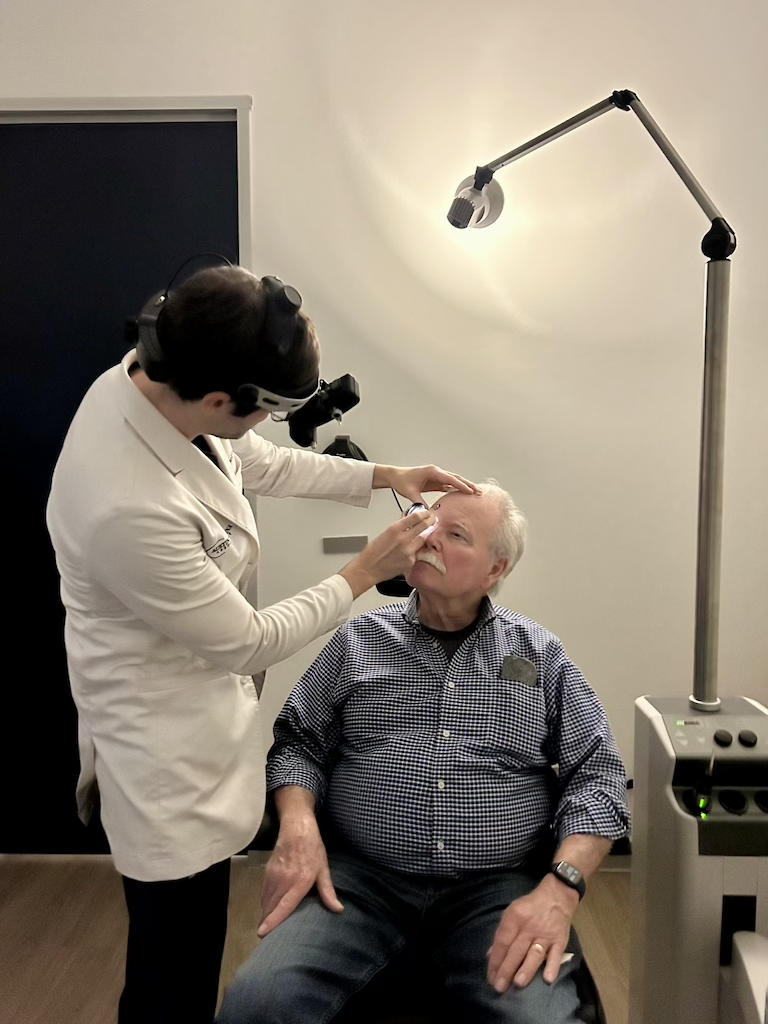How much do you know about AMD?

Approximately one out of every three Americans over the age of 75 years old is living with some form of age-related macular degeneration, or AMD. AMD is also the leading cause of blindness in those 55 years and older.
AMD is one of the many conditions that our team of board-certified retinal specialists treat regularly at Austin Retina Associates.
Since February is AMD and Low Vision Awareness Month, it is the perfect time to raise awareness and learn more about this condition.
What is AMD?
AMD occurs when cells within the retina’s macula break down over time and with age. The macula is responsible for our central vision which is necessary for tasks like reading, watching TV, and observing fine details.
It is diagnosed in one of two forms, Dry AMD (the most common) and Wet AMD. Dry AMD is associated with gradual vision loss while Wet AMD may cause more sudden sight challenges and results from abnormal blood vessels growing under the retina which may leak blood/fluid, thus the term ‘wet’ is used.
In addition to advanced age, other risk factors that may lead to AMD include genetics, smoking, high blood pressure or cardiovascular disease, and obesity.
Signs that you may be suffering from AMD are:
- Blurred central vision, inability to see fine details (such as faces or words/writing)
- Difficulty driving
- Challenges with spatial awareness or identifying objects in front of different backgrounds
How is AMD diagnosed?
According to board-certified retinal specialist Dr. Saagar N. Patel, “the hallmark sign of AMD is the presence of drusen.”
Drusen are small deposits of lipids and protein that form under the retina.
“A diagnosis of early age-related macular degeneration is based on seeing many small drusen in the macula,” explains Dr. Patel. This is accomplished via a dilated eye exam performed by an ophthalmologist.
What is the treatment for AMD?
Awareness and early detection/intervention provide the best foundation for effective treatment.
Although treatment depends on the type (Dry or Wet AMD), “it is most frequently treated with eye injections,” says board-certified retinal specialist Dr. Rolake Alabi. “Some patients with AMD may also be candidates for specialized laser treatments.”
Newer and more effective therapies to treat AMD are always in development, and at Austin Retina Associates, we pride ourselves in offering the most current treatment options and ability to participate in clinical research trials in order to help our patients prevent or restore vision loss.
Can AMD be prevented?
Research shows that certain lifestyle modifications can help slow the progression of AMD in those at risk, such as:
- Eating a healthy diet full of dark green, leafy vegetables, fish, and nuts
- Taking certain nutritional supplements like Vitamins C and E, Zinc Oxide, Copper, and Lutein
- Staying physically active and maintaining a healthy weight
- Managing high blood pressure and cholesterol levels
- Stopping smoking
Dr. Patel adds that annual dilated eye exams by certified eye care professionals once you are over the age of 60 are important to detect any serious conditions forming and prompt early intervention.
Consult with a Retina Specialist Today
Austin Retina Associates treats a wide range of retinal conditions. Our experienced team of retina specialists in Austin are dedicated to improving your vision and quality of life.
Contact us at 800-252-8259, or request an appointment online at one of our retina treatment centers located in Austin and throughout Central Texas.
For the latest Austin Retina news, visit our blog or follow us on Facebook and Instagram.

